Learn how to make homemade Kombu Dashi, a vegan-friendly Japanese soup stock, to enhance your Japanese dishes with umami flavor. It’s the easiest dashi that you can make!
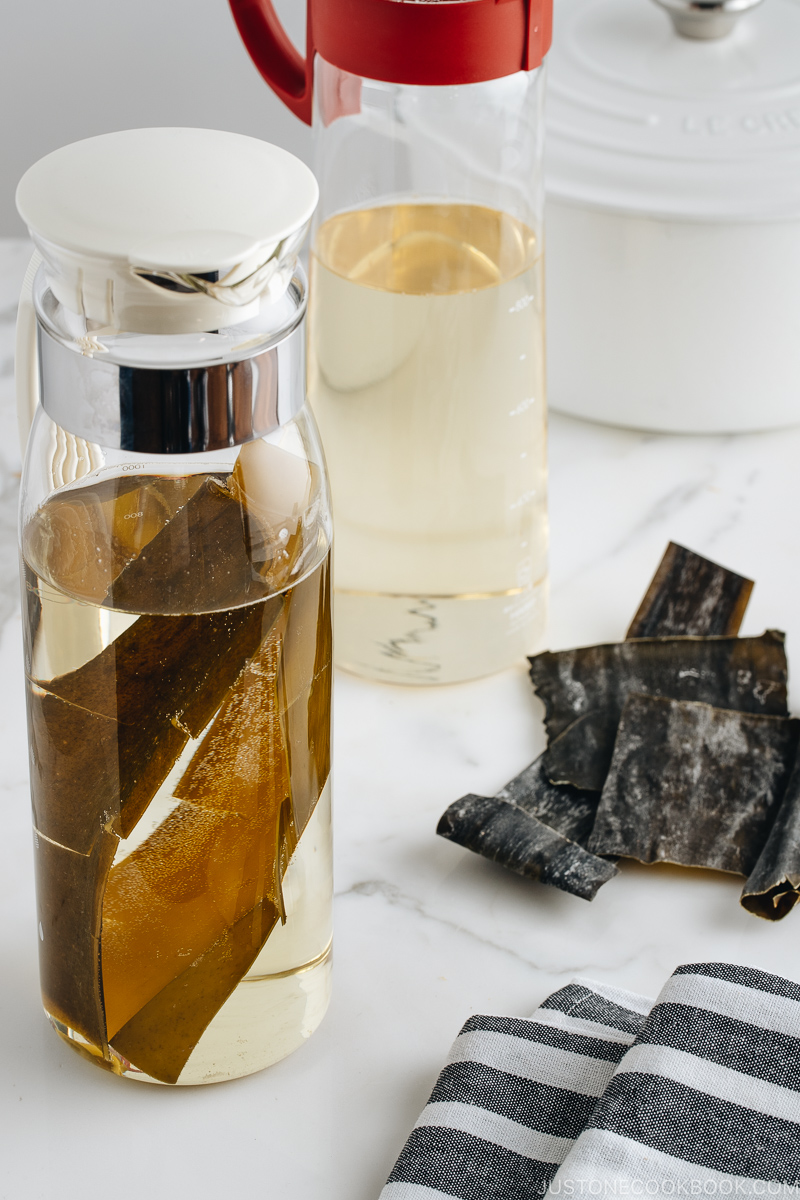
Dashi is Japanese soup stock that is a fundamental ingredient in many Japanese dishes to create authentic flavor. Today, I want to share how to make Kombu Dashi (昆布だし), a vegetarian and vegan soup stock that is the easiest dashi that you can make!
Table of Contents
What is Kombu Dashi?
Kombu Dashi (昆布だし) is a Japanese soup stock made with kombu (昆布, dried kelp). Kombu is used extensively in Japanese, Korean, and Chinese cooking. In Korean, it is referred to as dasima (다시마), and in Chinese as haidai (海带).
This sea vegetable earns its name as “the king of seaweeds” because it possesses an amazing flavor and nutritional value, unlike any other seaweed. The most noteworthy advantage is its high content of glutamic acid, an amino acid responsible for umami. And umami is what you’re looking for in a dish where it provides a complex, elemental taste.
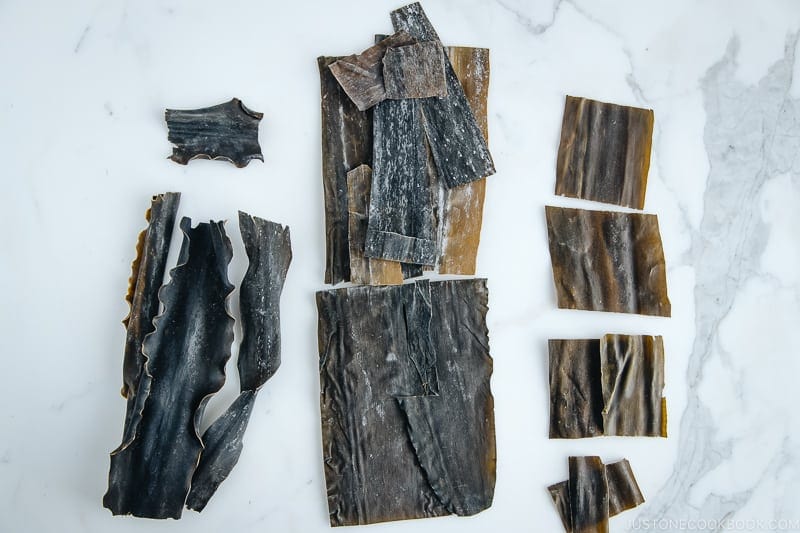
If you follow a vegetarian/vegan diet or simply want to embrace a more plant-based diet, kombu is an outstanding ingredient to incorporate into your cooking. Besides being a great flavor enhancer and tenderizer, kombu is a powerful, health-promoting food that can make up for certain nutrients that are absent in the diets.
In my pantry kombu page, I discuss different types of kombu and which kombu is good for specific types of dishes. Please go over the post if you want to know more about how to use kombu for Japanese cooking. You can find it at Japanese and Asian grocery stores.
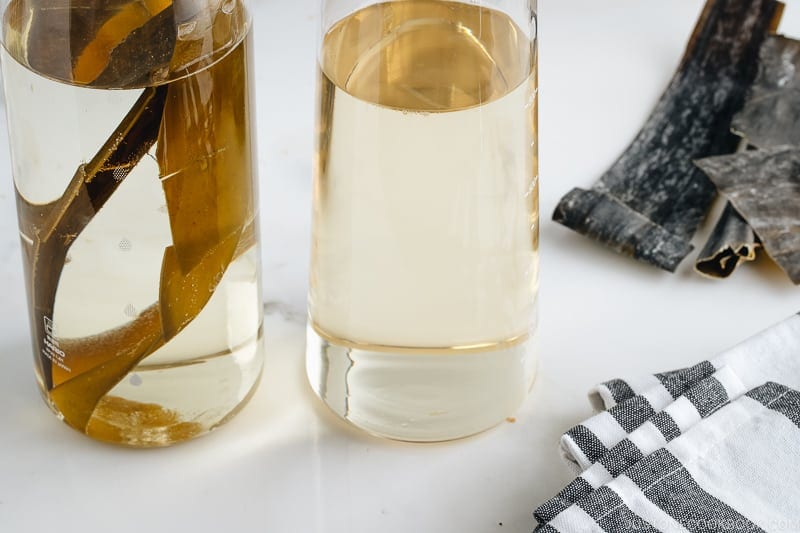
Ingredients You’ll Need
It takes just two ingredients to make this essential soup stock:
- kombu – dried kelp seaweed
- water
How to Make Kombu Dashi: Two Methods
Method 1: Cold Brew
The cold brew method known as mizudashi (水出し) is pretty hands-off. All you need is to put water and 1–2 kombu strips in a large bottle and let it steep for 2–3 hours or more.
Method 2: Hot Brew
If you need dashi right away, the hot brew or nidashi (煮出し) method is the one to use:
Just place the kombu and water in a medium pot and gently bring out the flavor. Turn off the heat just before it comes to a boil and remove the kelp.
Tips on Cooking with Kombu
- Don’t wash or wipe off the white powdery substance. The white powder compound known as mannitol is the key contributor to umami. The surface of kombu is pretty clean these days, so you may not need to wipe it.
- Make a couple of slits on the kombu to help release more flavor.
- Repurpose the leftover kombu into Kombu Tsukudani (Simmered Kombu) or Homemade Furikake (rice seasoning).
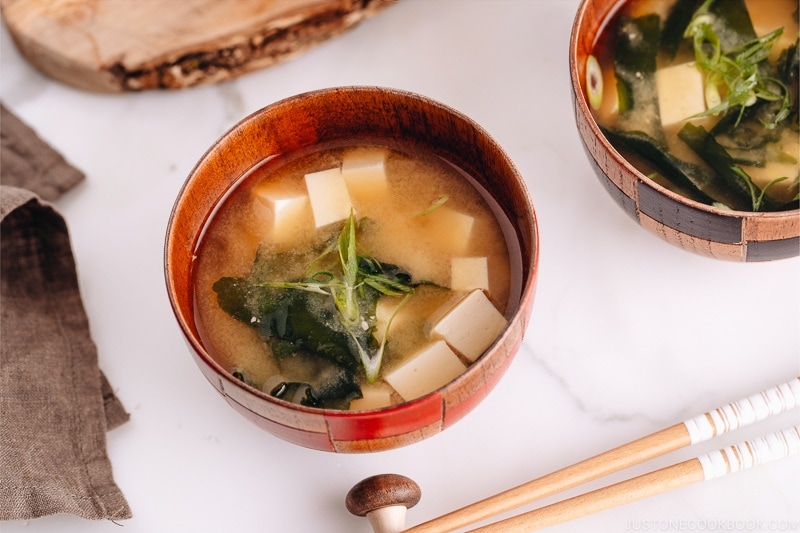
Recipes Using Kombu Dashi
Try these recipes that use kombu dashi stock for a flavorful broth:
- Shabu Shabu (hot pot with vegetables, tofu, meat, mushrooms, and udon noodles)
- Mizutaki (Chicken Hot Pot)
- Mizore Nabe (Hot Pot with Grated Daikon)
- Vegan Miso Soup
- Japanese Vegetable Soup (Kenchinjiru)
- Clear Clam Soup (Ushiojiru)
- Tomato and Tofu Miso Soup
If you can’t access kombu, another delicious option for vegetarian/vegan dashi is Shiitake Dashi.
The Ultimate Dashi Guide
Dashi plays an important role as a flavor enhancer in Japanese cooking, so you don’t need to season the food with too much salt, fat, and sugar. Rich in minerals and other vitamins, dashi is considered a healthy ingredient in our daily diet.
There are six different types of dashi you can use in Japanese cooking, including vegetarian and vegan dashi (*).
- Awase Dashi – a stock made from a combination of kombu + katsuobushi (dried bonito flakes)
- Kombu Dashi * – a stock made from kombu
- Katsuo Dashi – a stock made from dried bonito flakes
- Iriko Dashi – a stock made from dried anchovies/sardines
- Shiitake Dashi * – a stock made from dried shiitake mushrooms
- Vegan Dashi * – a stock made from dried shiitake mushrooms and kombu
If you are new to different types of dashi, check out my Ultimate Dashi Guide.
Wish to learn more about Japanese cooking? Sign up for our free newsletter to receive cooking tips & recipe updates! And stay in touch with me on Facebook, Pinterest, YouTube, and Instagram.

Kombu Dashi (Vegan Dashi)
Video
Ingredients
- 1 piece kombu (dried kelp) (10 g; 4 x 4 inches, 10 x 10 cm per piece)
- 4 cups water
Instructions
- Gather all the ingredients. Most Japanese recipes say to gently clean the kombu with a damp cloth. However, these days, kombu is pretty clean so just make sure it doesn‘t have any mold spots and it‘s ready to use. Do not wash or wipe off the white powdery substance as it has lots of umami.
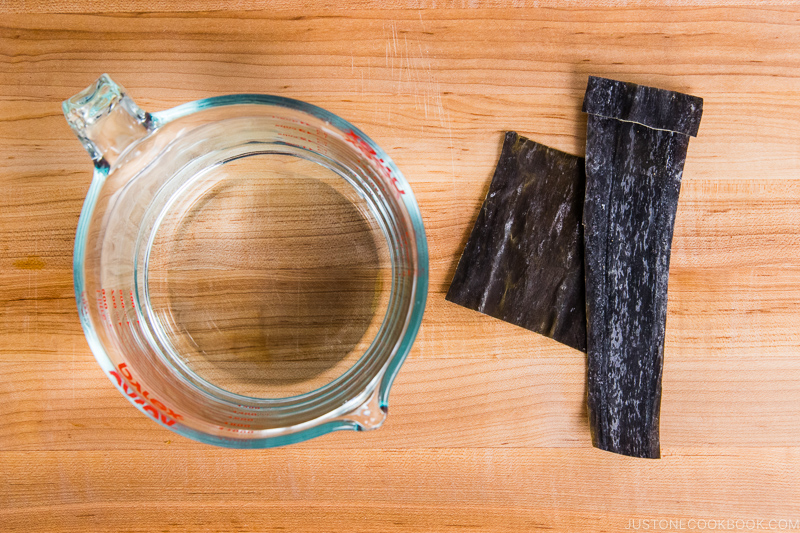
- Make a couple of slits on 1 piece kombu (dried kelp) to release more flavor.
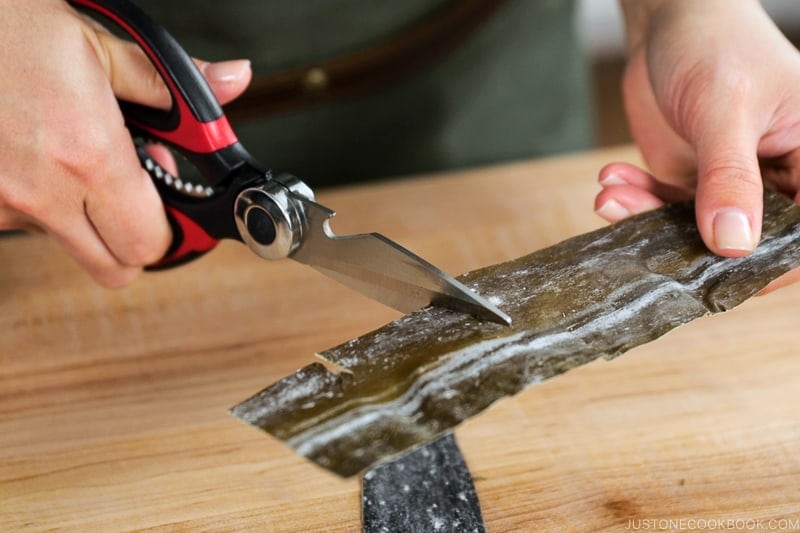
Method 1: Cold Brew Kombu Dashi (Mizudashi)
- Put 4 cups water and the kombu in a large bottle.
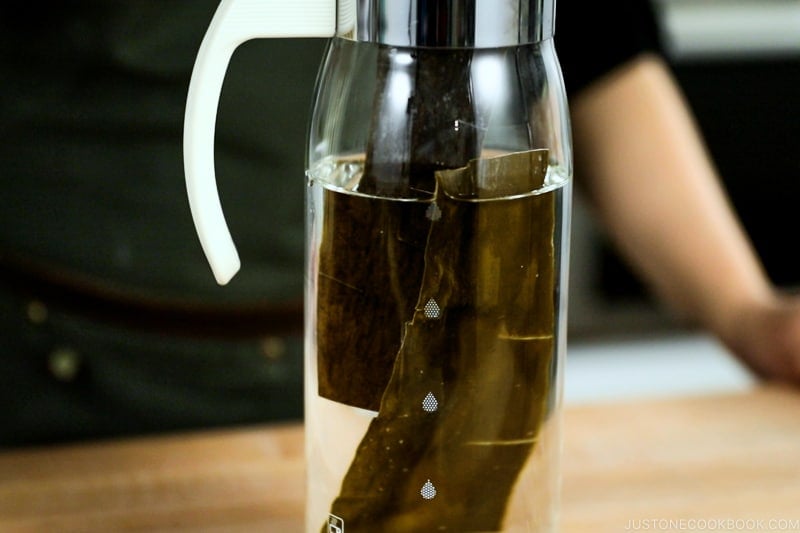
- Put the cap on and let it steep on the counter for 2–3 hours in the summertime and 4–5 hours in the wintertime. You can also cold brew the Kombu Dashi overnight in the refrigerator.
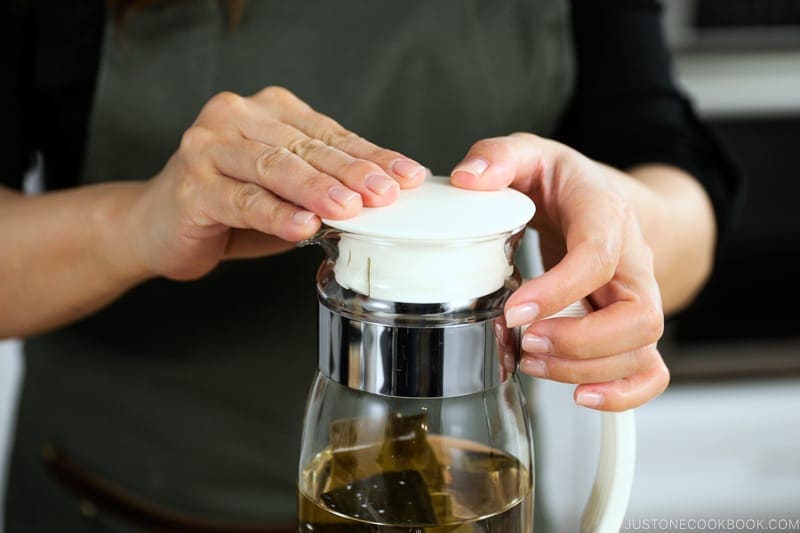
- Remove the kombu from the bottle and reserve the spent kombu (see below). The Kombu Dashi is now ready to use. If you are not using the dashi right away, save it in a bottle and keep in the refrigerator for 4–5 days or in the freezer for 2 weeks. I recommend using it sooner for the best flavor.
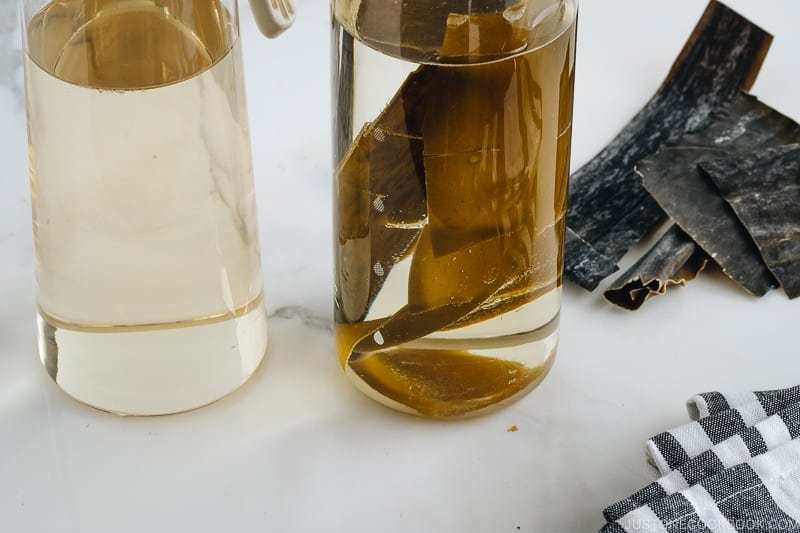
Method 2: Kombu Dashi on the Stovetop (Nidashi)
- Put the kombu and water in a medium pot. If you have time, soak for 3 hours or up to a half day. The kombu’s flavor comes out naturally from soaking in water.
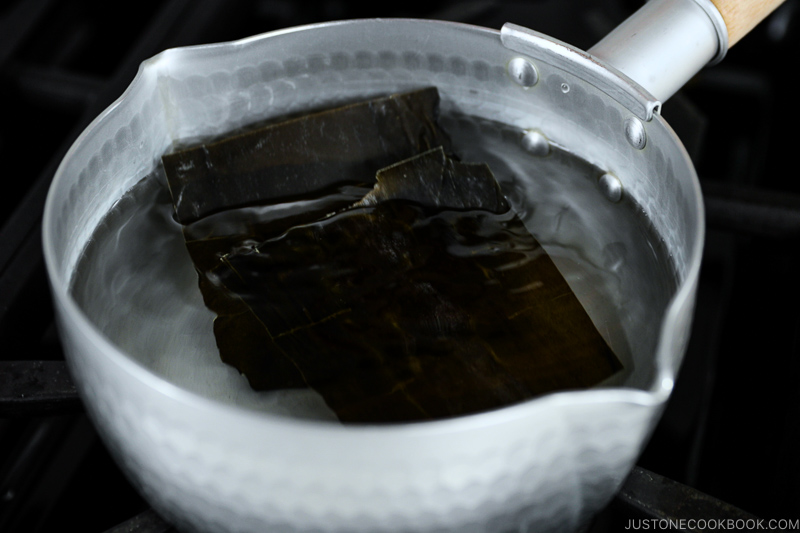
- Turn on the heat to medium low and slowly bring to a bare simmer, about 10 minutes.
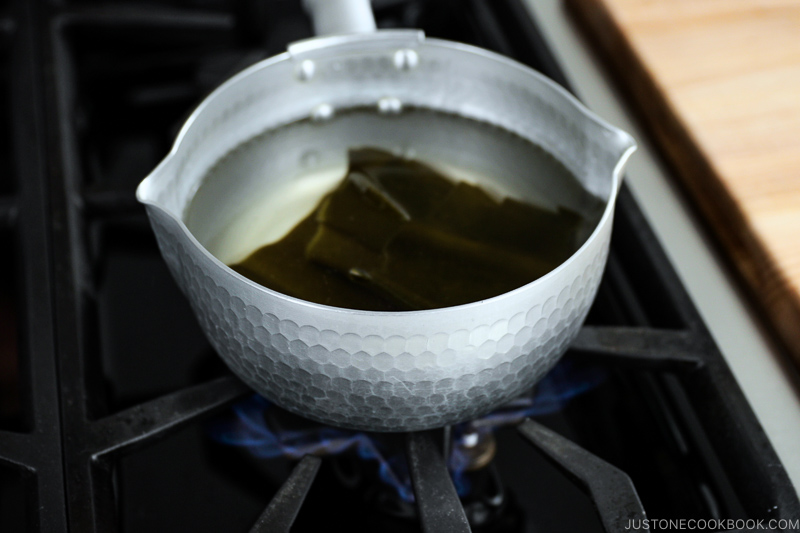
- Meanwhile, clean the dashi by skimming the foam from the surface with a fine-mesh skimmer.
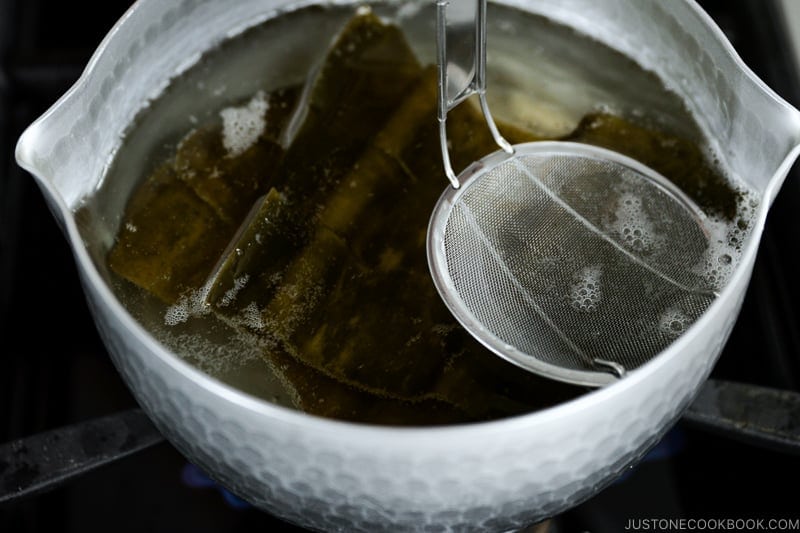
- Just before the dashi starts boiling, remove the kombu from the pot (see below for what to do with it). If you leave the kombu in the pot, the dashi will become slimy and bitter.
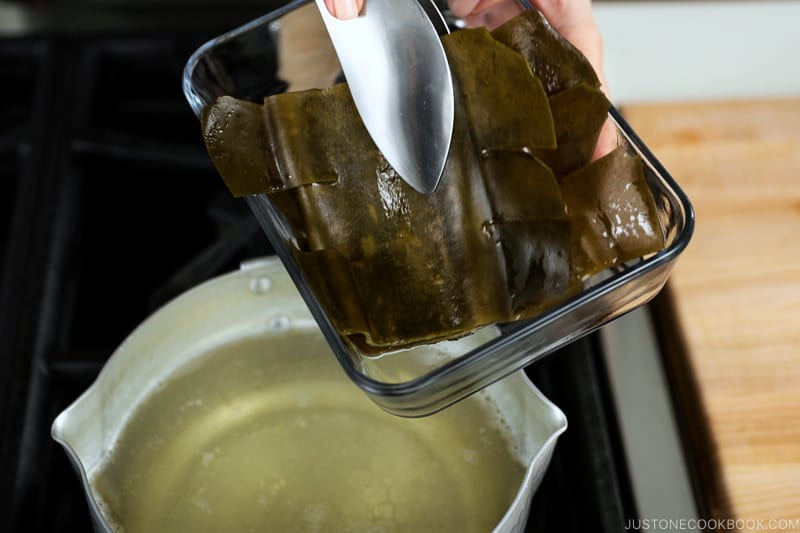
- Now the Kombu Dashi is ready to use.

To Store
- If you are not using the dashi right away, keep it in a bottle or airtight container and store in the refrigerator for 4–5 days or in the freezer for 2 weeks. I recommend using it sooner for the best flavor.
What to do with the spent kombu?
- Save the spent kombu in an airtight container and store it in the refrigerator for a week or in the freezer for up to a month.
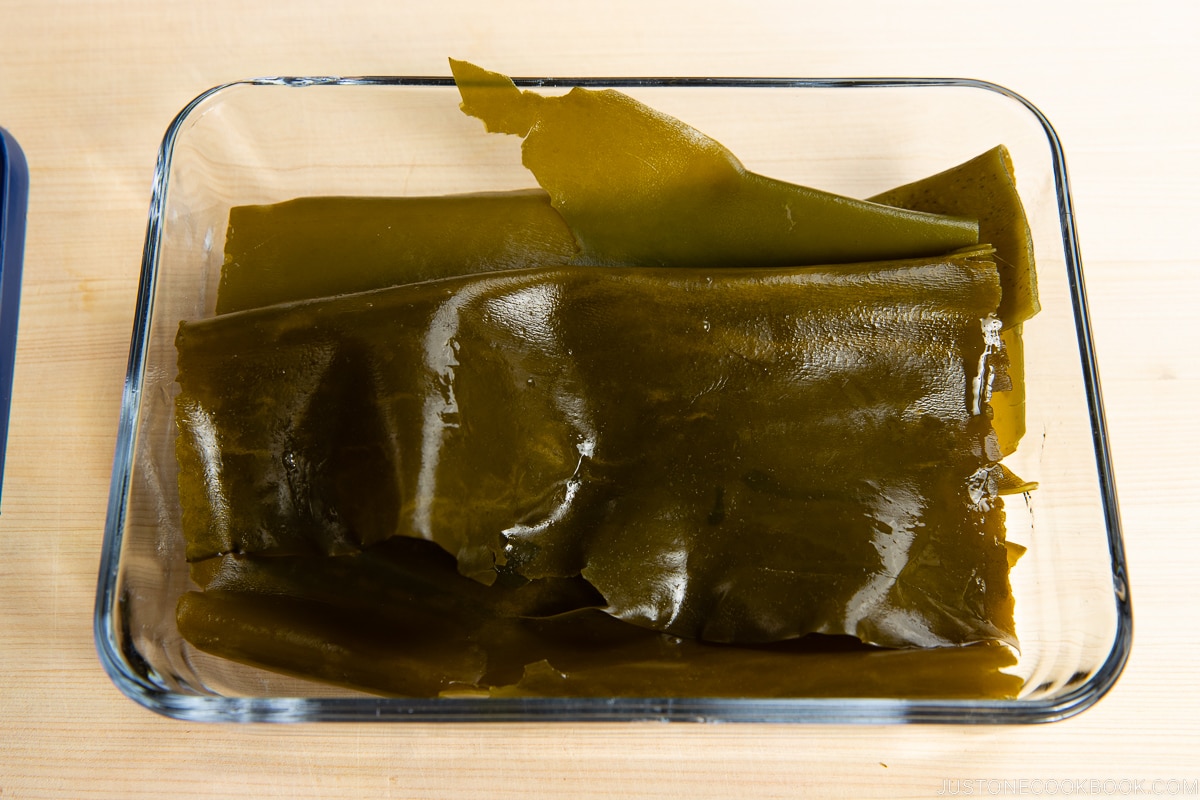
- With the spent kombu, you can make Simmered Kombu (Kombu Tsukudani).
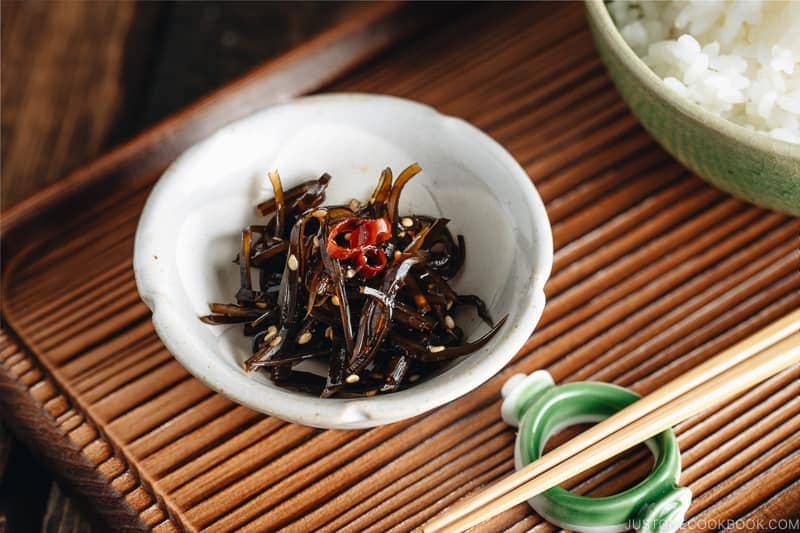
- You can also make Homemade Furikake (Rice Seasoning).
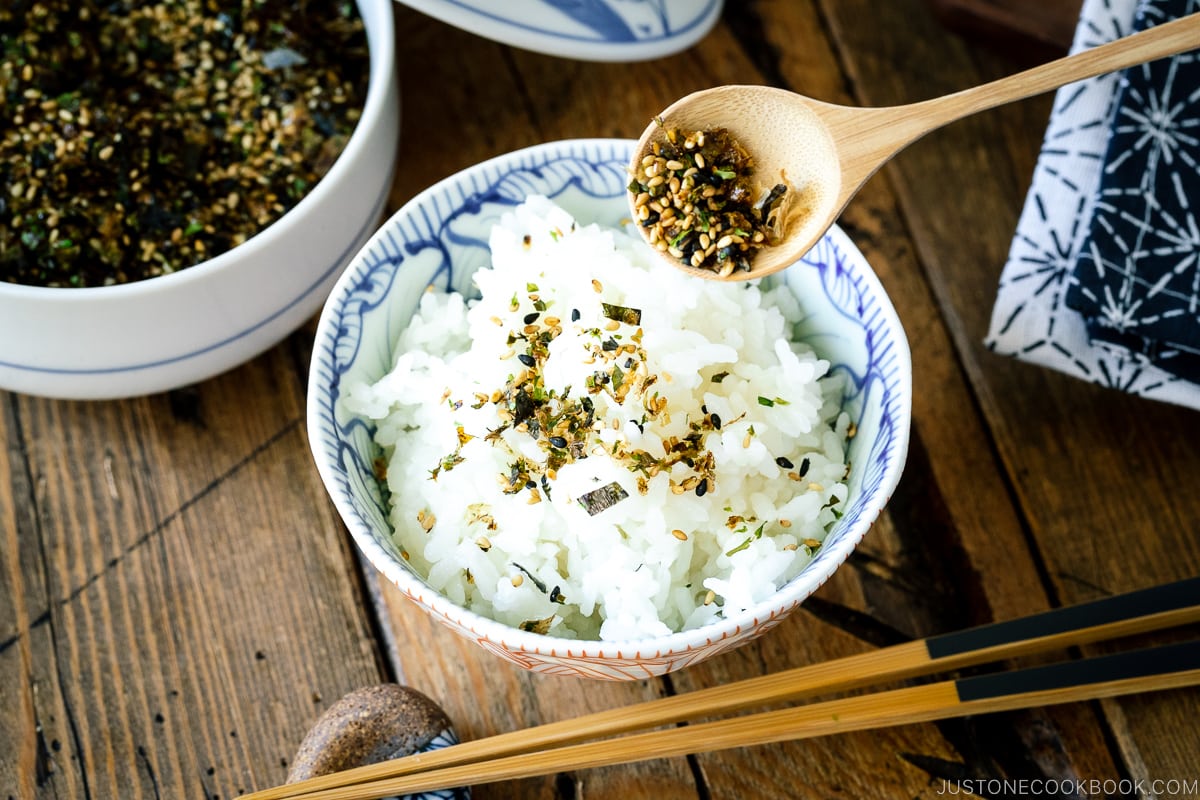
Nutrition
Editor’s Note: This post was originally published in February 2013. The images have been updated in April 2019.
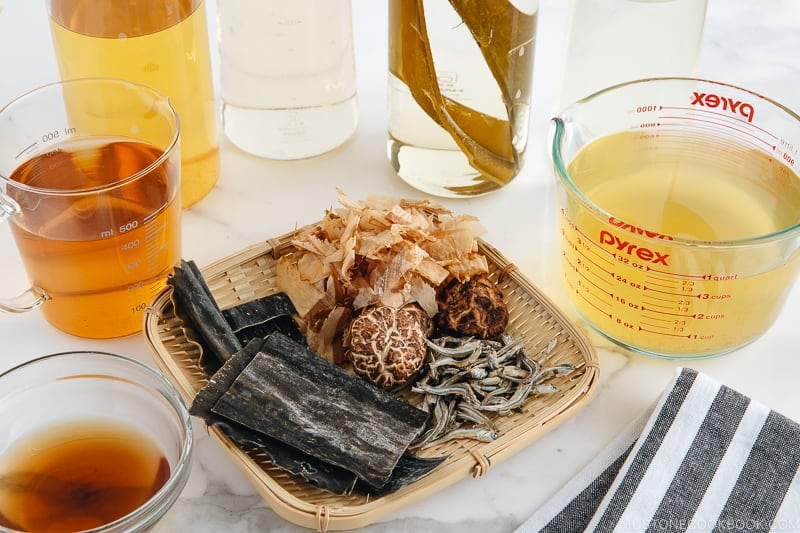
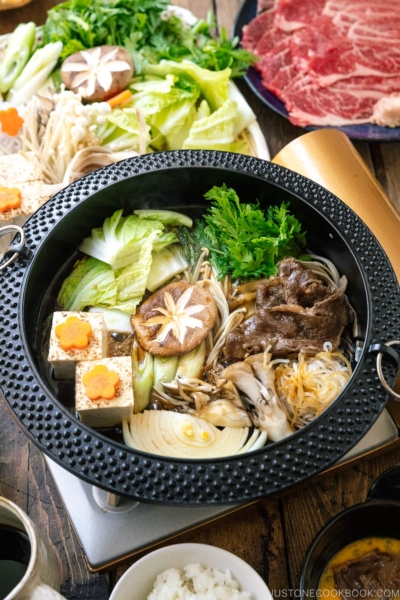
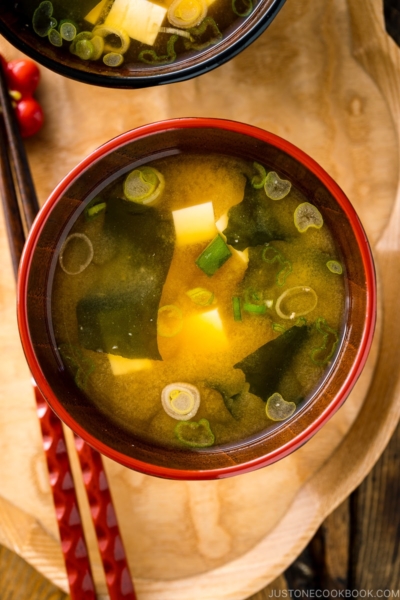
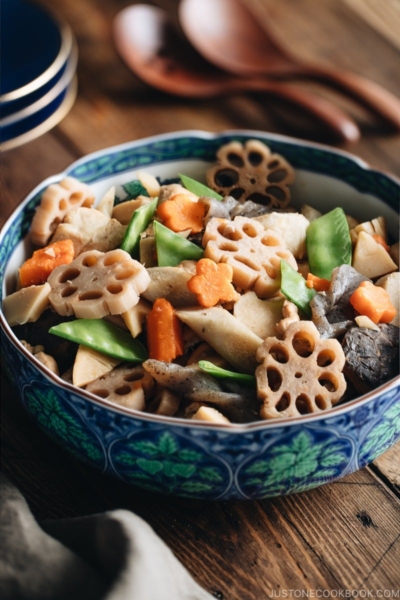
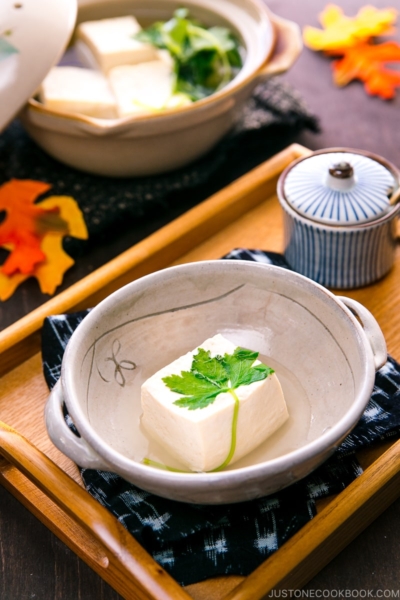




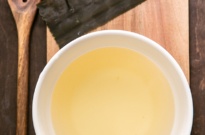
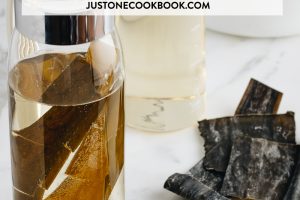
Is it possible to cold brew for too long? I had set mine up for an overnight in my fridge but had forgotten about it for a few days. Would it likely be okay? Or should I start a new brew? Thank you!
Hi Katrina,
Thank you very much for trying this recipe.
The Kombu will start to release too much Alginic acid in the Dashi after 12 hours and result in slimy Dashi. So it may not work as Dashi Stock. 😞
Hi, to make a really think and dense kombu dashi what would you do? I red a factory production system to do it but that’s a hell of a work but in the end you get a clean and pure kombu extract liquid which is very nice, but otherwise how could be possible to get a ekitai kombu dashi nice and dense?
Thank you!
Hi Paolo! I’m not sure how to make it at home except that you make concentrated kombu dashi and strain it… 🙂
Where did you get the two bottles?
Hi Acali! Do you mean these?
https://amzn.to/3eTQs3W (white one)
https://amzn.to/3eLTsiY (red/brown)
Hi Namiko,
I made this dashi via the counter method. I put many pieces of kombu in and I let it sit for about 5 hours. When I took out the kombu pieces, there was slime. I strained the dashi and it seems a little slimy but not too much. What do you think—should I start over, or would you use the dashi?
Many thanks for the recipe and advice!
Lisa
Hi Lisa! The slime for kombu dashi is normal, and you can only avoid it by decreasing the soaking time or using different types of kombu (there are different kinds of kombu – and each one is different how it hydrates). I’d use it, as it’s nothing wrong with it. When I make hot pot dishes, I soak my kombu in my donabe in the morning and leave it for dinner time. 🙂 In summertime (warm weather), I recommend placing the jar in the fridge to keep it safe. 🙂
I am really enjoying your recipes! I did the cold brew method and left the kombu in the refrigerator overnight. This morning it was covered in a gelatinous slime! Is that normal and can I still use the dashi?
Hi Zig! Thank you so much for your kind words! Hmm overnight is usually 8-12 hours, but was yours longer than that?
It depends on the type and quality of kombu too, and some can be softer faster than others, etc. Some kombu can be slimy if you soak for a long time, but overnight (8-12 hours) shouldn’t be too bad. And yes, you can use the kombu and cold brew kombu dashi. I may add more water if the water is too “thick”.
Hello Nami,
thanks for all the great veggie and vegan friendly recipes. I have litte trouble about finding the right amount of kombu to use because the Kombu I bought seems to be very light. 10×10 cm of kombu have a weight of less than 5 g, but in the recipes it is compared to 10g. So should I use as much kombu until it weights about 10g or is 10×10 enough and the weight isn’t that important.
Thanks in advance
Greetings
Leander
Hi Leander! Thank you for your kind feedback. I plan to share more veggie/vegan-friendly recipes in the future as we do have a lot of vegan dishes that are unfamiliar in the world. I would say to follow my weight measurement. There are so many different kinds of kombu and each one has different intensity of flavor. So try making one time and see if you feel it lacks the flavor, then add more. 🙂
Do you have a recipe for tsukudani
Hi Emily! I already photographed the Kombu no Tsukudani recipe but haven’t shared it yet. I am trying to get it out to the blog soon… Thank you for your request! 🙂
Greetings Nami-san
This Dashi was so flavourful
I soaked the Kombu overnight and made it in preparation for your Chikuzenni recipe .
Thank you for putting in so much thought about vegetarian and vegan eaters
As a vegan I am asked often “But what do you eat in Japanese food ?”
I point them to your site 😊
With many thanks
Sujatha
Hello Sujatha! I’m really happy to hear you liked the flavor of kombu dashi. Haha, you’re too kind for pointing your friends to my site. Thank you so much!
Hi Nami, I find that whenever I make kombu dashi it’s almost a bit *too* sea-like for my tastes. Even when I add a little to my recipes it’s still overpowering the flavor, and I find better results when using dashi powder instead.
I usually soak a 4×4 piece in 3 cups of water for 3 hours and heat until little bubbles form at the bottom of the pot. Any thoughts?
Thanks,
Sarah
Hi Sarah! The kombu:water ration in this recipe is pretty standard for “kombu dashi” (not with other ingredients like dried bonito flakes/katsuobushi). However, you can reduce the amount of kombu if it’s too strong. Depending on the recipe, I change the amount of kombu too – or maybe I don’t have a good size kombu and I use less piece. That’s okay too.
I would rather use a real kombu than kombu dashi powder if you don’t mind using a real kombu. Dashi powder is great and convenient but the fragrance and flavors don’t last long. And it usually has salt and MSG in it (there are no MSG type available).
Well, if it is for me, I’d reduce the kombu size in half, and maybe cut down on soaking time, slowly heat the water immediately after dropping kombu in the water. 🙂
Thank you Nami! I’ll try your suggestions out. I have so much kombu left from the first time I bought it so it can’t hurt to try. I’m okay with powder but I think going the purist route is bound to surpass it 🙂
Hi Sarah! I hope you will find the right amount of kombu to your liking! 🙂
Hello,
I want to say thank you, for this great blog. I also have a question: Why should I leave the Mizudashi in summer 2 hours and in winter 4 hours in the fridge?
Hi Felix! Oh my goodness, thank you so much for finding my error. We steep the kombu outside the fridge, winter is cooler which is why it takes a longer time to steep. Thank you so much for letting me know. I didn’t even notice till now (almost 6 years later)…
Hello Nami,
We make a lot of fresh dashi at home and usually just dump the kelp (in my compost) afterwards which has always seemed a bit of a waste.
I dont know if there is a Japanese use for it other than Furikkake but on a Yangtze river cruise I’ve just returned from they served a kelp salad (cold) at breakfast and my wife and I rather liked it.
A quick search found this recipe on line and having made it a couple of times now its texture and flavour is virtually identical to what we were eating there.
https://www.chinasichuanfood.com/kelp-salad/
My next batch of dashi will have the kombu re-used for this salad.
I used kikomen soy, dash of mirrin, dash of fresh cumquat juice and rice wine vinegar to the above recipe.
Just a thought, If you deem this post inappropriate as it references another web site I fully understand and please delete it.
All the best
Charles
Hi Charles! No problem at all, as Elaine is my blogging pal. 🙂
In Japan, we have Simmered Kombu dish that we can make with leftover kombu. I will have to make this recipe as I keep getting questions similar to yours. I’ll add to my to do list. Thank you for your request! It’s basically cook kombu strips in soy sauce, sugar, mirin base sauce. 🙂
Can different kinds of seaweed be used? Like laver?
Hi Alexander! For dashi, we only use kombu. There are so many types of “seaweed” but kombu is the one to make stock in Japan. 🙂
Hi Nami, I am about to make my own dashi for some Miso soup. I have 2 questions?
1. Why is it necessary to line the strainer (sieve) with a paper towel (cheese cloth/linen cloth)? Why can’t you just strain the dashi through the sieve without it? I also saw this method for bonito flakes as well. It’s like you’re using 2 filters to strain.
2- I have 2 unopened packages of kombu (seaweed) that have 2 to 3 yr old expiration dates. I did some research and found that kombu seaweed doesn’t have a real expiration date. At the grocery store, any packaged product, including kombu seaweed, is required to print expiration date on their package. As long as kombu seaweed is kept in a dark cold place, it can be used for almost forever unless molded. I, however did not store it in a cold dark place but instead had it on an open shelf near my kitchen. I did open one package today and they seemed okay, had a bit of white on it and were stiff when I broke them off. How can I tell if they’re bad? Should I throw them out and buy a new package?
Hi Kazy! I apologize for my late response… I just came back from Japan. I’ve been delaying my responses. Sorry about that.
1) If your sieve is super fine mesh, you don’t have to line with paper towel/cheese cloth/cotton cloth. Now that I have a fine mesh sieve, it can catch small kombu particles easily without lining.
2) What you said is true, and it’s your call. I have a feeling from your description that it seems okay to me. Unless it’s clearly a mold, I wouldn’t worry. The dark place helps especially if it’s humid weather in Japan.
Reading the comic 「サチのお寺ごはん」(東京:秋田書店、平成27)[“Sachi’s Temple Meals” in my poor translation]、I learned how to make soy dashi. It was delicious, but might be even m0re so if mixed with your KOMBU DASHI!! DAIZU DASHI is also vegetarian, of course. One might better use the refrigerator, as you do for soaking the kombu, when soaking the roasted soybeans-in-water to make Dashi, especially in the warmer seasons. Then, one may eat the remaining soybeans with a favorite flavoring added. I tried using already roasted soybeans (the ones used for Setsubun) instead of dry-fry-pan roasting them myself. It worked, even though I did not adjust the amount of soybeans (about one part to five parts water).
I guess a bit lighter amount of soy would be appropriate.
Thank you for sharing the information Christina! I’d love to taste soy dashi (with kombu dashi) one day! 🙂
“Gently clean the dashi kombu with a damp cloth but leave the white powdery substance (Mannitol) which contribute to the umami flavor in dashi.”
I don’t think it’s possible to clean the kombu with a damp while leaving the white substance. It rubs off.
Hi Sarah! “Gently clean the kombu wiht a damp cloth” is a common step/method in every Japanese cooking recipe (that involves kombu). You don’t need to wipe off, but it’s like dabbing. These days kombu is much cleaner and less dirty, but it’s the common cooking practice from the old days that we still do…